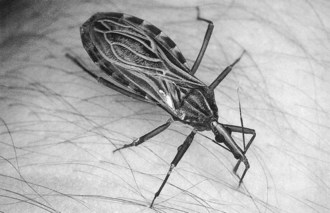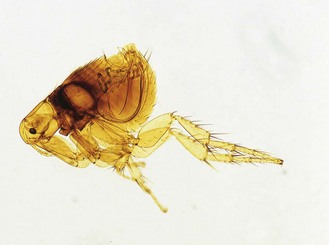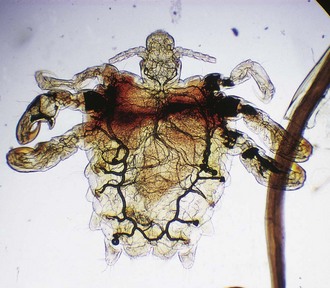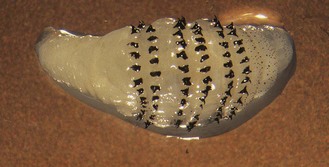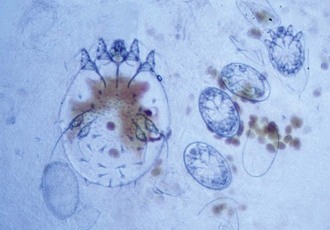64 Arthropods
Arthropod-borne diseases; ectoparasitic infections; allergy
Key points
• Medically important arthropods include insects (bugs, flies, gnats, lice and fleas) and arachnids (spiders, ticks and mites).
• Many arthropods act as accidental or obligatory vectors of bacteria, viruses, protozoa or helminths.
• Certain fleas, lice and mites are human parasites.
• Some arthropods cause allergies (e.g. house dust mites); others may cause painful bites or stings.
• Myisais is a condition caused by invasion of the body by insect larvae.
Arthropods are invertebrate animals with jointed legs, segmented bodies and chitinous exoskeletons. They are hugely diverse and incredibly numerous – more than 850 000 species have been described (probably only one-tenth of the true number). Strictly speaking, the term ‘arthropod’ includes the crustaceans (e.g. lobsters and crabs), the myriapods (e.g. millipedes and centipedes) and some minor groups, but these seldom cause much serious mischief, and most medical interest centres on the insects (e.g. mosquitoes, fleas and lice) and the arachnids (e.g. mites, ticks and spiders). A simplified classification and relevance scheme is shown in Table 64.1.
Table 64.1 Simplified classification of arthropods of medical importance
| Class | Members of class | Medical importance |
|---|---|---|
| Insects | Ants, bees, wasps (Hymenoptera) | Venomous bites and stings |
| Beetles (Coleoptera) | Some secrete fluids causing blisters | |
| Bugs (Hemiptera) | Bites; vectors of Chagas’ disease | |
| Butterflies and moths (Lepidoptera) | Urticaria (caterpillars) | |
| Cockroaches (Dictyoptera) | Mechanical vectors of disease | |
| Fleas (Siphonaptera) | Ectoparasites; vector of plague | |
| Flies and gnats (Diptera) | Vectors of many viral and parasitic diseases; myiasis | |
| Lice (Phthiraptera) | Ectoparasites; vectors of typhus, trench fever, relapsing fever | |
| Arachnids | Spiders and scorpions | Venomous bites and stings |
| Ticks | Vectors of rickettsiae, borreliae | |
| Mites | Scabies; allergy; vectors of scrub typhus, rickettsial pox | |
| Pentastomes | Tongue worms | Animal parasites; human infestations rare |
| Myriapods | Centipedes and millipedes | Some cause painful bites or secrete fluids causing blisters |
| Crustacea | Crabs, crayfish | Intermediate host of lung fluke |
| Copepods | Intermediate host of fish tapeworm and guinea-worm |
Medical importance of arthropods
Insects and other arthropods are mainly of importance in human disease in three ways:
1. as vectors of the agents of bacterial, viral or parasitic infection
2. as parasites in their own right, spending part or all of their lifespan on humans
3. as instigators of allergic responses that vary in severity.
In addition, many arthropods have a considerable nuisance effect because of their biting or stinging habits, and these occasionally give rise to serious, even life-threatening, reactions.
The larvae (maggots) of some common flies that feed on decomposing matter have been used for centuries to treat infected lesions. There is renewed interest in this phenomenon as wound therapy, as the maggots not only scavenge dead tissue, but also appear to secrete factors conducive to wound healing.
Abnormal fear of insects or other arthropods (e.g. arachnophobia; excessive fear of spiders) is well recognized, as are delusions of infestation with these creatures. The mere mention of head lice can make people scratch their scalps. Distinguishing between the real and the imaginary can test the diagnostic acumen of the attending physician. Persistent cases may need psychiatric referral.
Arthropods as disease vectors
Mechanical transmission
Insects such as flies, ants and cockroaches that are attracted by food can transmit pathogenic micro-organisms passively. The common housefly, Musca domestica, is a particular nuisance because of its predilection for decaying matter, its mobility and its habit (shared by a number of other flies) of regurgitating gut contents and defecating on food. While such flies can undoubtedly play a role in the transmission of enteric diseases, and also trachoma, along with cockroaches they are of lesser importance in modern urban settings than in poorer communities where lower standards of sanitation and hygiene prevail.
Intermediate hosts
A wide variety of arthropods act as obligatory hosts in the transmission of viral, bacterial, protozoal and helminthic agents of human disease. Their association with particular vectors is mentioned below and their role in individual diseases is dealt with in appropriate chapters elsewhere in the book.
Arthropods as ectoparasites
Many insects, ticks and mites pester humans to obtain a blood meal, or spend part or all of their life in association with human beings. Several fleas, lice and mites are among those that are adapted in various ways for life on humans. Occasionally, humans act as the host of the larval stages of certain insects, and this invasive condition is known as myiasis.
Arthropods as allergens
Stinging insects and other venomous arthropods can give rise to severe reactions in hypersensitive individuals, and anaphylactic reactions need immediate treatment with adrenaline (epinephrine). The hairs of several caterpillar species found in various parts of the world are irritating and may give rise to urticaria if brushed against. The irritating reactions to the bites of mosquitoes, midges, fleas and some other insects are immunological reactions to the salivary secretions that are injected at the bite site. However, the degree of reaction can vary remarkably between individuals, from little or no reaction to quite severe dermal and systemic affects and may need medical attention in the latter cases.
Various domestic arthropods, such as dust mites and cockroaches have been incriminated as a cause of asthma in atopic subjects; their allergens can be present in dead bodies as well as in the live individuals, and also secreted in the faeces.
Insects
Insects are the most numerous and familiar form of arthropod life. They are characterized by having six legs and segmented bodies. The legs (and wings, if present) are carried on the thoracic segment between the head, which bears sucking or biting mouthparts, and the abdomen. Most insects of medical importance, apart from lice and bugs, undergo complete metamorphosis, developing from eggs to adults through morphologically distinct active larval but often inactive pupal stages inside which the adult is developing.
Ants, bees and wasps (Hymenoptera)
These insects have little medical relevance apart from their propensity to retaliate to disturbance with defensive bites or stings. These can be serious if the subject is hypersensitive, but are usually trivial. Particularly notorious are the African honey bees (Apis mellifera scutellata), the European wasp (Vespula germanica) and the South American fire ants (Solenopsis spp.), all of which have been introduced into various countries, and also the Bull ants (Myrmecia spp.) of Australia. Other ants also forage in urban areas wherever food is to be found and frequently infest kitchens and food stores; they have some potential to transfer pathogenic organisms (particularly in hospitals).
Beetles (Coleoptera)
Some beetles act as intermediate host of the dwarf tapeworm Hymenolepis diminuta, an uncommon human parasite of minor importance (see p. 665). Otherwise, their only real medical significance lies in the fact that the body fluids of certain beetles (e.g. Meloid and Staphylinid species) can cause blistering of the skin. One such beetle, ‘Spanish fly’, is the source of cantharidin, a vesiculating agent.
Bugs (Hemiptera)
The bugs of importance in human medicine are blood-sucking species. Most familiar throughout the world is the common bed bug, Cimex lectularius, which in recent years has been undergoing a widespread international resurgence in distribution and abundance. There is also a tropical species, C. hemipterus, which is confined to warmer climes. They have a body that is flattened dorsoventrally and from a distance they resemble brown lentils. Bed bugs live in cracks and crevices of walls, floorboards and furniture, from where they emerge to take a periodic blood meal whenever it is on offer. The adults are long-lived and can survive up to a year without a blood meal. They are usually spread between premises in infested furniture or personal baggage. There is no evidence that they transmit disease.
Reduviid bugs (colloquially known as kissing bugs or assassin bugs) transmit the trypanosome protozoan that causes Chagas disease in Central and South America (see p. 651). Various species of Triatoma, Rhodnius and Panstrongylus are implicated. They are about 2.5 cm in length, much larger than bed bugs and, unlike them, they have wings (Fig. 64.1). They are usually active at night, settling on the face of an unsuspecting sleeper to take a blood meal and to defecate on site. The infective trypanosomes are in the hindgut and the bitten person becomes infected by rubbing the bug’s faeces into the irritating bite wound or mucous membranes.
Butterflies and moths (Lepidoptera)
Adult butterflies and moths are of no great medical significance (although there is one species that feeds on the blood of large mammals in Southeast Asia, and some that feed on the discharge from the eyes of mammals, including humans) but hairs of certain caterpillars can cause skin rashes, through contact with either fine urticarial spines or stronger hollow spines that contain a venom.
Cockroaches (Blattaria)
Cockroaches are of little medical significance. They can harbour various pathogens (viruses, bacteria and protozoans) but, as with houseflies, they are of lesser significance in modern urban settings than in developing regions with less sanitary conditions. In modern cities, however, they are also known to be responsible for allergy-related conditions including asthma.
Fleas (Siphonaptera)
Fleas are small blood-sucking parasites. Their laterally flattened bodies and lack of wings enable them to negotiate the hairs and feathers of their animal hosts. Well-developed hind legs enable them to jump from host to host (Fig. 64.2). Many fleas will feed on humans if given the opportunity, as those who have been attacked by the common cat flea Ctenocephalides felis can bear witness. However, the species that is adapted for life on humans is the human flea, Pulex irritans, which is still common throughout the world. Female fleas of another species, Tunga penetrans, known as chigoes or jiggers, attack humans by burrowing into the underside skin of the foot, or under the toenails, and the abdomen of the gravid female becomes grossly distended with eggs, causing pain, irritation and, sometimes, secondary infection. These fleas are common in dry, sandy soil, mainly in Africa and parts of Central and South America.
Human or cat fleas are seldom implicated in the transmission of disease, but some other species are important disease vectors. Most notorious is the rat flea, Xenopsylla cheopis, which is the most important, but not the sole, vector of the bacterium that is responsible for plague (see p. 350 and Fig. 64.2). Some forms of rickettsial typhus are also transmitted by rodent fleas (see Table 40.1, p. 391).
Lice (Anoplura)
Lice are wingless insects that undergo incomplete metamorphosis during their development. The ones that parasitize humans are blood-sucking species with flattened bodies and short legs that are adapted to cling to hairs or clothing. Body lice and head lice are variants of the same species, Pediculus humanus. Although the body louse, P. humanus corporis, is somewhat larger than the head louse, P. humanus capitis, and there are other minor differences, they are not readily distinguishable. A third species, Pthirus pubis, is quite distinct morphologically, living up to its common description as the ‘crab’ louse (Fig. 64.3). Head lice are usually confined to the hairs of the scalp, but body lice live in clothing covering the body, rather than on the skin itself. P. pubis, as the name suggests, is usually found on pubic hairs, but may also infest other hairy parts, including body and axillary hair in adults and eyelashes in children. All types attach their characteristic eggs (often called nits) to body hairs (head and crab louse) or clothing fibres (body louse), and effective treatment involves removal of the eggs as well as dealing with the adults.
Body lice are the classic vectors of the rickettsia that causes epidemic typhus (see p. 393) and the spirochaete that causes relapsing fever (see p. 371), but head and pubic lice are generally not involved as vectors of pathogens. Lice also cause irritation, and continuous scratching may lead to various forms of infective dermatitis.
Lice are very common throughout the world and head lice, in particular, often spread quickly between school children, even in affluent areas. Treatment with insecticides such as permethrin, malathion and carbaryl may be effective, but chemical resistance is widespread, and there are also fears about the possible neurotoxicity of malathion and the mutagenic potential of carbaryl, so unnecessary repeat treatments should be avoided. Repeated ‘wet-combing’ with a fine-tooth comb after shampooing the hair and applying conditioner can succeed in eliminating an infestation, although reinfection from untreated family members or school contacts is common. The same insecticidal treatments can be effective against pubic lice but all body hair should be treated and, as the infestation is transmitted by intimate contact, sexual partners should also be treated.
Flies (Diptera)
Dipterous insects are usually active flyers as adults, with a pair of wings used for flying and an additional vestigial pair, known as halteres, which are used as organs of balance. The developmental cycle from egg to adult fly involves complete metamorphosis. As well as being among the most annoying of insect pests, many biting flies have an obligate role in the transmission of a wide variety of important infections (Table 64.2). The larvae of certain flies may also infest wounds and others are able to penetrate skin, causing myiasis (see below).
Table 64.2 Principal infections associated with biting flies, mosquitoes and midges
| Type of insect | Diseases transmitted |
|---|---|
| Biting midges (Culicoides spp.) | Filariasis (Mansonella spp.) |
| Black-flies (Simulium spp.) | Onchocerciasis |
| Deer flies (Chrysops spp.) | Loiasis |
| Mosquitoes: | |
| Anopheline (Anopheles spp.) | Malaria; bancroftian filariasis |
| Culicine (Culex, Aedes, Mansonia spp.) | Bancroftian and brugian filariasis; yellow fever, dengue and other arbovirus infections |
| Sandflies (Phlebotomus, Lutzomyia spp.) | Leishmaniasis; Oroya fever; sandfly fever |
| Tsetse flies (Glossina spp.) | African trypanosomiasis |
Mosquitoes
Mosquitoes are readily recognized by a long needle-like proboscis (Fig. 64.4). Adult males and females both feed on plant juices, but the female needs blood for the development of her eggs, and is a voracious predator on a wide variety of vertebrate animals throughout the world. Mosquitoes of importance in human medicine are divided into two broad types: anopheline mosquitoes, numerous Anopheles species of which transmit the protozoans that cause malaria in humans and result in great mortality in tropical countries (see p. 674), and culicine mosquitoes (e.g. Culex and Aedes spp.), which are the vectors of many so-called arboviruses (arthropod-borne viruses), such as yellow fever, dengue, West Nile, Japanese encephalitis, chikungunya, Ockelbo and Ross River viruses, that can cause various encephalitis, haemorrhagic and polyarthritic symptoms in both tropical and temperate regions (see Ch. 51). Both anopheline and culicine mosquitoes also act as the intermediate hosts of certain nematodes that cause lymphatic filariasis (see Ch. 63).
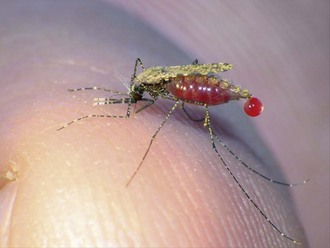
Fig. 64.4 A female anopheline mosquito, the vector of human malaria.
(Photograph courtesy of Dr S Doggett, Westmead Hospital, Sydney, Australia.)
Female mosquitoes lay their eggs on water or on surfaces that will be flooded; larvae and pupae are both aquatic. Most Anopheles and Culex mosquitoes prefer relatively permanent water bodies that do not dry up, but Aedes spp. will utilize temporary habitats, such as created by flood- and tidal-waters, and also small pockets of water, such as in rock-pools, tree-holes, discarded containers, water butts, etc. Some adults can disperse widely and may be found several kilometres from their breeding ground, while others are very limited in their range.
Biting midges
Biting midges are tiny flies that are able to cause a nuisance out of all proportion to their size. They arise from mostly aquatic or semi-aquatic habitats and the females attack in swarms, usually in the evening, and may give rise to painful and intensely itchy reactions. These midges are more important in veterinary than human medicine as vectors of arboviruses, although some Culicoides spp. transmit filarial nematodes of Mansonella spp. to humans in parts of Africa and Central/South America (see p. 660).
Sandflies
Sandflies are small enough to penetrate most mosquito netting. They have terrestrial (not aquatic) habitats and utilise dark, humid natural hollows areas, such as rodent burrows or termite mounds, but are often also found in or around human earthen dwellings and associated animal shelters. Female flies suck blood, usually at night, but have limited flight range, so that the diseases they transmit – notably the visceral (kala azar) and cutaneous (e.g. oriental sore) forms of leishmaniasis (see p. 652), bacterial bartonellosis (see p. 347) and viral sandfly fever (see p. 534) – tend to be localized in distribution. Species associated with disease transmission in Africa, the Middle East, Asia and the Mediterranean littoral belong to the genus Phlebotomus, while in Central and South America the vectors of the various pathogens are species of Lutzomyia.
Other biting flies
Although flies that are capable of inflicting a painful bite, such as the stable-fly Stomoxys calcitrans, various black-flies and tabanids are found throughout the world and can be serious nuisance pests in temperate regions, species that are important vectors of human disease are restricted in distribution to areas of the tropics.
Black-flies (Simulium species) are the vectors of the filaria that causes onchocerciasis (river blindness; see Ch. 63) in parts of tropical Africa, and also Central and South America, and are associated with flowing rivers where the immature stages are attached to vegetation or rock substrates. The adults are small hump-backed flies that often attack in swarms but only the females feed on blood. Species in the Simulium damnosum complex and the S. neavei group are important vectors in western and eastern regions of Africa, respectively, while other species such as S. ochraceum and S. metallicum transmit the infection in the Americas.
Tsetse-flies, Glossina spp., are large flies found only in Africa, where they transmit the protozoans that are responsible for trypanosomiasis (’sleeping sickness’) in humans as well as in cattle and other animals (see p. 650). The immature stages are associated with dry terrestrial habitats where mature larvae are deposited on friable soil that they penetrate for pupal development and, unusually, both male and female adults feed on blood. The vectors of human trypanosomiasis in areas of West Africa are riverine species belonging to the Glossina palpalis group, whereas species in the G. morsitans group, which prefer savannah plains and woodlands, are the principal vectors in the eastern part of the continent.
Tabanids (sometimes known as deer-flies) are large flies that can act as vectors of the filarial worm Loa loa (see p. 658) in tropical West and Central Africa, where Chrysops dimidiatus and C. silaceus breed in aquatic or semi-aquatic muddy or marshy areas of the rainforests. Other tabanid species, known throughout the world by various common names such as horse-flies, clegs and March-flies, have very painful bites but generally are not involved in disease transmission (although some have been associated with tularaemia and anthrax).
Myiasis
Given the chance, many common flies that usually lay their eggs or larvae on carrion, will deposit eggs or first stage larvae on exposed human tissues of ulcers and sores, which consequently become infested with the maggots. The condition is known as semi-specific or facultative myiasis to distinguish it from specific or obligatory myiasis, in which humans and other animals act as obligate hosts for the larval stage of development of certain species. Accidental myiasis is said to occur when larvae are ingested with food, or incidentally invade orifices such as the urogenital tract.
Myiasis is of great economic importance in animal husbandry throughout the world, but human infestation is largely a problem of the tropics. Obligatory myiasis in Africa is most commonly caused by Cordylobia anthropophaga (the tumbu fly) or C. rodhaini (Lund’s fly). In Central and South America Dermatobia hominis (the human bot fly) is the usual culprit. Cordylobia lays its eggs in soil or dust contaminated with urine or faeces and humans are infested when contacting that substrate, but Dermatobia attaches its eggs to other insects (including mosquitoes) that are attracted to humans. When the larvae hatch they burrow into the skin of the individual with whom they are in contact and remain there, breathing through spiracles at the posterior end until they are ready to pupate and emerge. This is also termed cutaneous myiasis and is a transient condition resulting in boil-like lesions in the skin. The body of the larva is furnished with spines (Fig. 64.5), which make it difficult to remove, but covering the lesion (and thus the posterior spiracles) with a gel substance (such as petroleum jelly, vaseline) prevents the larva from breathing and encourages it to emerge with the help of digital pressure. There should be no subsequent problem with the lesion, providing care is taken not to allow it to become secondarily infected.
Larvae of another African fly, Auchmeromyia luteola (the Congo floor maggot), also ‘parasitize’ humans, but they do not penetrate the skin, preferring instead to suck the blood of unsuspecting sleepers.
Arachnids
Of most importance in this group are spiders, scorpions, ticks and mites. Unlike insects, the adult forms have eight legs and are invariably wingless. They have two main body regions – cephalothorax and abdomen – which in mites and ticks are fused to give the appearance of a single segment. They develop by incomplete metamorphosis, and immature forms resemble small versions of adults. However, ticks and mites acquire the full complement of eight legs only as they mature from larvae to nymphs during their progression to adulthood.
Mites
Despite their name, mites are variable in size, although many, including those commonly implicated in human disease, are so small as to be almost invisible to the naked eye. The only strictly human parasites are Sarcoptes scabiei (the itch mite), Demodex folliculorum and Demodex brevis (the follicle mites).
The human itch mite, Sarcoptes scabiei, is related to mites causing mange in various animals (Fig. 64.6). It is the cause of scabies, an infestation of the skin that is still very prevalent in many countries. After fertilization on the surface of the skin, the gravid female mite burrows into the epidermis, eventually leaving behind a trail of about 40 eggs. The larvae usually hatch in 3–4 days, leave the burrow and pass through nymphal stages to reach adulthood in hair follicles. Burrowing females cause intense itching. There may be a rash on the trunk but this is unrelated to the distribution of the mites, which are most often found in folds of thin skin, especially between the fingers, often on the wrists and elbows, the axillae, and penis in men and breasts in women. There may be secondary bacterial infection that complicates diagnosis and treatment, and elderly and immunocompromised patients may develop a severe keratotic crusting infestation known as crusted (previously Norwegian) scabies, which can cause outbreaks in institutions and may be misdiagnosed as psoriasis. Application of an aqueous solution of malathion or permethrin is often successful therapy, but household contacts should also be treated. Crusted scabies can be treated systemically with the anthelminthic agent ivermectin, which is widely used in animal husbandry for the control of ectoparasites.
Demodex spp., the follicle (or blackhead) mites have an elongated body adapted for its life in hair follicles and sebaceous glands on the face, commonly around the nose, on the cheeks or eyelashes. They seldom cause much pathology (although they have been associated with acne and other skin conditions), but can be treated with permethrin application or sulphur preparations.
Other species that impact on human health occupy a wide variety of habitats that humans enter or entertain, and human contact with certain species in their environment may lead to an intense pruritus or dermatitis. Mites associated with commensal birds and rodents (Ornithonyssus spp.), and stored grains or dry foodstuffs (e.g. Tyrophagus putrescentiae and related spp.), can cause serious dermatological irritation.
Dust mites (Dermatophagoides spp. and Euroglyphus spp.) have attracted considerable attention as a precipitating cause of atopic disease, including asthma and eczema (see above). The Dermatophagoides species (usually D. pteronyssinus in Europe and more commonly D. farinae in North America) flourish in centrally heated homes with wall-to-wall carpeting. They feed on flakes of skin and have been incriminated as a cause of asthma in atopic subjects. The allergens are present in the dead bodies and also secreted in the mites’ faeces.
The most important mite-borne pathogenic disease is scrub typhus (see p. 393), a potentially fatal rickettsial infection with a localized but widespread distribution in eastern and southeastern Asia to northern Australia.
Ticks
Ticks are essentially large mites, but they are much more important as vectors of human disease. They are conveniently classified into two main families: hard (ixodid) ticks, which have a chitinous shield (scutum) on the back (Fig. 64.7), and soft (argasid) ticks, which lack this feature. In addition, the head parts of soft ticks are hidden on the ventral surface and are not visible from above. Ticks are obligate blood-feeders. They parasitize a very wide variety of animals in nature and many species will attack humans, given the opportunity. The initial bite is usually painless, but it can give rise to a serious reaction and, in some countries (notably Canada, the USA and Australia), ixodid ticks are responsible for tick paralysis, a potentially fatal condition caused by a neurotoxin injected while the tick feeds.
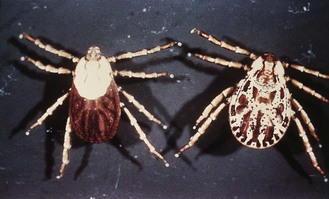
Fig. 64.7 Dermacentor andersoni, the vector of Rocky Mountain spotted fever and a cause of tick paralysis. These are known as ‘hard ticks’ because of the presence of the dorsal scutum, prominent in the male (right), but much reduced in the female (left).
Ixodid ticks also transmit many rickettsiae of the spotted fever group (see p. 393), as well as the agents of rickettsial Q fever, spirochaetal Lyme disease (see p. 372), bacterial tularaemia (see p. 357), protozoan babesiosis (see p. 653) and arboviruses (see Ch. 51) that can cause encephalitis. Adults, especially the females, gorge on blood for long periods, and efforts to remove them manually often leave the head embedded in the skin. However, the developmental stages (larvae, nymphs and adults) may not remain on the same host and some of the most important species involved in disease transmission, such as Dermacentor andersoni and Ixodes ricinus, are known as three host ticks. Larvae that acquire micro-organisms remain infected through the nymphal and adult stages (trans-stadial transmission); the adult can, in turn, pass on infection to the next generation through the eggs (transovarial transmission). Thus, spread of infection to new hosts may be very efficient.
Argasid ticks tend to be ‘nest ticks’, prefering to attack a resting or sleeping host at night, and do not remain attached to the host after feeding. They are relatively long-lived and inhabit dry, dusty environments, mainly in hot countries. The most important species from a medical point of view is Ornithodoros moubata, the main vector of tick-borne borreliosis (relapsing fever) in tropical Africa (see p. 371). Other species of Ornithodoros transmit American forms of relapsing fever and some are notorious for their voracious feeding habits and extremely painful bites.
Spiders and scorpions
Although all spiders kill their prey by injecting venom, the toxin is usually innocuous to humans, and the mouthparts (chelicerae) are seldom robust enough to allow penetration of human skin. The sting of scorpions, which is carried at the end of an elongated extension of the abdomen, can penetrate human skin, but the venom is usually of low potency (although it can be sufficient to make children ill).
Some spiders and scorpions have painful bites or stings and a few can cause serious, occasionally fatal, illness by virtue of powerful neurotoxins. The most dangerous spider is the Australian funnel web spider, Atrax robustus, but species of Latrodectus (including types of black widow spider, found in many areas of the world, and the Australian redback spider) can also inflict a serious bite. The venom of some Loxosceles spiders encountered in the USA and South America may cause tissue necrosis.
The most dangerous scorpions belong to the large Buthidae family. Buthid scorpions with dangerous stings are most commonly found in parts of Africa, the Middle East, the southern states of the USA and Central America. They are nocturnal creatures and sting as a defensive reaction. Most human cases of scorpion bite occur when the arthropod seeks shelter in shoes or other clothing.
Spider and scorpion wounds seldom need more than supportive treatment. Antivenoms are sometimes available in areas where the more dangerous species are prevalent.
Other arthropods
Some centipedes can inflict a painful bite and some millipedes can secrete a fluid capable of raising blisters. Crustaceans (crabs and crayfish) are of interest in human medicine mainly as intermediate hosts of Paragonimus westermani, the lung fluke (see p. 663). Copepods (water fleas) are similarly important only as hosts of the guinea-worm, Dracunculus medinensis (see p. 664–5) and the fish tapeworm, Diphyllobothrium latum (see p. 664–5).
Goddard J. Physician’s Guide to Arthropods of Medical Importance, ed 5. Boca Raton: CRC Press; 2007.
Kettle DS. Medical and Veterinary Entomology, ed 2. Wallingford: CABI publications; 1995.
Mullen G, Durden L. Medical and Veterinary Entomology, ed 2. Burlington: Academic Press; 2009.
Service MW. Medical Entomology for Students, ed 4. Cambridge: Cambridge University Press; 2008.
Iowa State University Entomology Index of Internet Resources. http://www.ent.iastate.edu/list/directory/114/vid/5.
